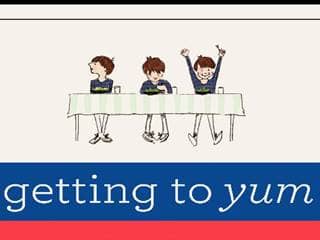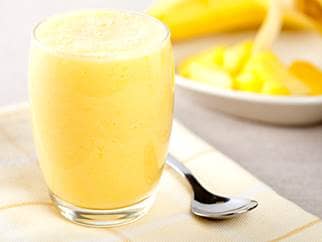
Foregoing is excerpted from Getting to YUM: The 7 Secrets of Raising Eager Eaters by Karen LeBillon
When I first met Jessica, her 3-year-old son, Lucas, would not eat a single vegetable. Not one! Among Lucas’s list of forbidden foods were meat (with the exception of hot dogs), “mushy” foods (even roasted potatoes), and “anything green.” Jessica was at her wits’ end. “The dinner table feels like a battleground. I leave feeling so stressed. My husband and I don’t know what else to do,” she told me.
A few months after adopting the taste-training method in this book, Lucas’s eating habits dramatically improved. Previously off-limits foods were now among Lucas’s favorites: green beans, oranges, grapefruit—even raw spinach. Best of all, Lucas’s baby sister, who benefited from taste training right from the start, happily eats anything put in front of her. “As a result of taste training,” Jessica explained, “we ’ve adopted new routines that have changed our family’s eating habits for the better.”
What is taste training, and why is it useful for parents? Taste training is a hands-on, practical approach to food education that uses games and fun activities to help children learn to like healthy foods. The underlying principle is that children can learn to eat well, just as they learn to read. The idea that taste can be taught is a hopeful, positive message. The goal is simple: children will enjoy eating healthy foods because they want to (not because they have to). Your children will develop positive eating routines (how, where, and when to eat) that foster balanced appetites and healthy attitudes to food. They’ll be healthy, happy, savvy eaters.
Of course, many food cultures—the French, the Italians, the Japanese, to name a few—have been practicing their version of taste training for generations. It’s only recently that scientists and educators have studied the effects of taste training, and explained how and why it works so well. Researchers have spent the past few decades doing hundreds of amazing (and sometimes downright funny) experiments on babies and children: feeding babies slightly acidic water (their “sour face” looks just like an adult’s); asking toddlers to eat fake green “grasshopper” icing (they will, happily); or dyeing food blue to see if peer pressure works to encourage reluctant kids to eat “scary” things (it does).
The core message of the scientific research on taste training is simple and inspiring: kids can actually learn to like new tastes (even if they are cautious about them at first).
And that’s not all. Specific taste-training techniques improve children’s eating habits, make them more willing to try new foods, and change their long-term eating habits for the better. Kids who have gone through taste training eat healthy foods more regularly and eagerly, even months after the taste training is over. In fact, scientific studies show that taste training works better than nutrition-focused education methods.
Charming Citrus
We don’t often think of citrus as a food to give to children. We tend to think of it as strong, even aggressive; and we assume that small children don’t like sour tastes. But your kids might surprise you! The test families agree: these were some of the easiest, tastiest recipes that they tried. Everyone was pleasantly surprised.
Tangy Citrus Smoothie
Icon B Recipe
Equipment: blender / Preparation: 4 minutes / Cooking: none / Servings: 2 adults and 2 children (small “tasting” servings)
Smoothies (just like soups) are a great way to introduce new flavors to your kids. The creamy, smooth texture makes them a natural hit with kids of all ages. Plus, they’re versatile: my test families served this recipe for breakfast, snack, and dessert!
Note: I wouldn’t recommend serving this before twelve months, and then only in small quantities (having made sure that you have tested these ingredients with your child first, one by one, to watch for any allergic reactions). If they do react, best to wait. My older daughter used to react to tomatoes (a red rash around the mouth) and my younger one to kiwis. This eventually went away on by itself. No rush! There are lots of other ingredients you can substitute. This recipe is very flexible, so you can mix and match ingredients. Kids love experimenting in the kitchen, and coming up with “their” smoothie recipe is a lot of fun (and a great way to get them taste testing!).
By the way, if you don’t like smoothies, this recipe might change your mind. My test families report that those who don’t like the standard smoothie flavors (such as berry) were surprised to find the citrus to be so tasty!
Taste Training Tip: Smoothies concentrate tastes, making them more intense. For younger kids, or those new to tangy tastes, this smoothie will probably need the yogurt as well as the avocado, which will reduce the acidity level and give a rich taste that will balance the sour taste—making it interesting rather than overly strong.
1 cup orange juice
Juice of 1/2 lemon
1 big ripe banana (or 2 small ripe bananas)
½ cup plain yogurt (or flavored, if your kids are not citrus lovers)
One of the following: half a fresh grapefruit (peeled), 1 cup diced pineapple, or 1 kiwi (peeled)
2 ice cubes
2 tablespoons honey
Optional: 1 ripe avocado, peeled and pitted (again, a good idea if your kids are not citrus lovers)
Place all the ingredients in a blender and mix until smooth and frothy. Yum!
Taste Training Tip: I serve this recipe in tiny kid-size teacups or tall thin juice glasses (or even cocktail glasses). This is a “tasting” recipe—so kids don’t need a lot.


